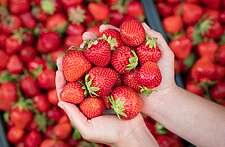By Cynthia Maxwell, Trend Forecasting
The interest surrounding circadian rhythms increased when The 2017 Nobel Prize in Physiology was awarded to Jeffrey C. Hall, Michael Rosbash, and Michael W. Young "for their discoveries of molecular mechanisms controlling the circadian rhythm." (nobelprize.org) In more understandable terms, Psychology Today defines circadian rhythms as the "body clock," the circadian rhythm is a cycle that tells our bodies when to sleep, rise, and eat—regulating many physiological processes." Still a little confused? Think about how a hibiscus flower opens when the sun comes out and closes when the sun goes down. The melatonin in our bodies decreases when exposed to light and increases as the sun goes down. We can interrupt the increase and decrease of melatonin with conflicting lifestyle habits like added stress. Circadian rhythm knowledge can lead us to adopt better practices.
The ancient science of Ayurveda has referenced circadian rhythms long before the present day to live a healthier quality of life, better energy levels, better sleep, and digestion. Daily habits like eating quality food, sleeping, and exercising according to the cycles of our biological clocks are all part of the circadian theory. With the global wellness market valued at over $4 trillion, circadian rhythms will be just one of consumers' and businesses' new wellness paths. Here are just a few fresh food and beverage trends and how they benefit our daily health and wellness.
Related: Back to the Future: Functional Health Trends from Ayurveda to Gut Health
Heritage
Eating foods from our region and honoring the nutrition of our ancestors is a powerful step in becoming more in touch with our heritage and nurturing our health. Heritage-inspired foods can bring a sense of comfort and evoke nostalgic emotions. Chef Crystal Wahpepah of restaurant Wahpepah's Kitchen in Oakland, California, is an enrolled member of the Kickapoo Nation of Oklahoma. She was raised in a multi-tribal urban Native community on Ohlone land in Oakland. One of Crystal's objectives for her restaurant is to "educate communities and organizations on the health benefits of Native foodways." Crystal wants to share the experiences that were passed down to her.
Foraged
Foraging and locally grown foods trends for 2022 fall right in line with the theory that eating nourishing quality foods is healthier for the body and mind. From an Ayurvedic perspective, the closer the produce is to where you live, the more "prana," or energy and nutrients it contains. Farmed and foraged choices support consumers' interest in sustainability and health and wellness trends. The farm-to-table movement will continue to grow as chefs desire to partner with local farmers. But what are the new foraged trends on the rise? We know many varieties of mushrooms have been hot for years now, and we will continue to see fungi impact food and beverage in new ways. Most spring mushrooms are safe if you're ready to forage your own, but it is always good to double-check the varieties you dig up.
This year we will see foraged leaves enter the ring with our fungi favs. In Philadelphia and LA, fig leaf syrups, marinades, and powders are used in ice cream and cocktails. The leaves are great wrapped around fish and meats steamed, grilled, and baked, releasing a delicious coconut flavor. Studies show that the fig leaf might help blood sugar levels. Good taste, great health benefits! The perilla leaf grows well in Houston and has a minty licorice taste. Look for them in desserts, cocktails, pork, beef, and fish dishes. I also predict nettle and dandelion as foraged trend favorites. Nettle is great for allergy symptoms and is high in iron and protein.
 Dandelion is probably growing wild in your backyard right now, or you may see it on your daily walking path. Its liver cleansing capabilities are exceptional, and the bitter-tasting profile is right on trend for 2022. Used now in salads and cocktails, also look for it to expand into new consumer categories over the next few years.
Dandelion is probably growing wild in your backyard right now, or you may see it on your daily walking path. Its liver cleansing capabilities are exceptional, and the bitter-tasting profile is right on trend for 2022. Used now in salads and cocktails, also look for it to expand into new consumer categories over the next few years.
Artisanal
When consumers start to embrace the natural cycles of the day, it will bring on a sense of creativity, connection to heritage crafts and foods, and curiosity surrounding outdoor activities. The pandemic required us to slow down, connect with family, and in turn, brought on a significant cook-at-home trend, particularly the exploration of bread making. Garden supplies sales increased as many embraced growing their own food. These trends will continue to grow as they align perfectly with the increased interest in circadian rhythms. A return to cooking at home and growing our food has increased our desire for local and regional-inspired menus. Now that consumers are starting to dine out more, they may not be so satisfied with the usual fare and will seek out newness. Chefs embrace unusual and artisanal ingredients and experiential ways of crafting cocktails. Bison and alligator are new meat options and restaurants that offer local, sustainable fish. If there is a story behind the product, it will have those unique artisanal qualities consumers seek out. Look for bars that feature local brews, mezcal sourced from family-run Palenque's, regional vodkas, bourbons, and tequilas. Artisanal ingredient trends will also continue to drive the need for farmers and seasonal markets.
It has been interesting to see the interwovenness of culture, food sourcing, and health and wellness over the last few years. I am appreciative of chefs finding new tasty ways to approach a healthier way of eating. Our plates and glasses will be filled with exciting and healthy creations, and our body clocks will thank us!
For more Food and Beverage Trends, Subsribe to our weekly newsletter HERE






